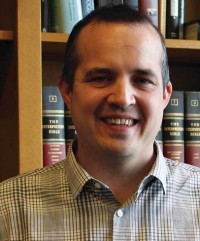A fourth year of lections?
I've had a convert's fervor for liturgical worship ever since I stumbled upon an ELCA music position as a recent Wheaton College grad with a very low-church background. (When my much-younger sister advanced pretty far in the state spelling bee but didn't win, my dad told her to call me. "I lost on a word I've never heard of: 'liturgy,'" she said. "Dad said you'd know why that was funny.")
But only in the last couple years have I become a bona fide lectionary nerd. It began right before the Century site launched in 2010, when I was burning the midnight oil putting together our lectionary browsing tool. I wanted to get it all programmed for several years beyond the calendars offered by sites such as Vanderbilt's, so I had to do my own math—meaning I actually had to learn how the thing works.
My mild-to-moderate-obsessive side found it engrossing. "Wow," I'd say to my wife, "there are nine Sundays after the Epiphany in 2011. That almost never happens!" I figured that the fact that she's super churchy herself would make her drop everything and come study old calendars with me, but I guess she had a sermon to write or something.
Now and then I'll see a blog post or comment that asks if anyone's compiled all the parts of the Bible that the Revised Common Lectionary omits. So one day last year I opened up my reverse lectionary spreadsheet and started in on Matthew, figuring I'd get through the gospels and get a blog post out of the list of references.
But soon I got distracted from the subject, until a commenter on James McGrath's blog directed me to someone who's more than a few steps ahead of me on this: Timothy Matthew Slemmons, whose blog, The Year D Project, crafts many of these neglected passages into a fourth lectionary year. Here's his explanation as to why and how. Recently he put out a book on this subject; I haven't read it yet but intend to. I'll likely write something more substantial at that point; for now I'll say simply that in general this seems to me like a fine idea.
One question I have, which Slemmons may well address in the book: once I've convinced my congregation that we need to read more of the Bible in worship (easy, right?), what's a good way to go about incorporating Year D as an early-adopter church? It'd be a shame to simply switch to a four-year cycle, thus going entirely off the cycle other churches follow (except for every 12th year, when the three- and four-year cycles would coincide...).
The best I can come up with is to do a three-year cycle that leaves a different year out each time around but prioritizes keeping the other two in their conventional sequence. That is, a 12-year cycle with only Year D spaced evenly: ABC / DBC / ADC / ABD. Of course, this would mean routinely fasting from, say, the Parable of the Good Samaritan for a span of six years. Which might seem especially silly when you're instead sitting through/preaching a sermon on some passage that, on second thought, maybe it wasn't so bad to leave out after all.
Still, I appreciate Slemmons's point here—"that the canon of Scripture is the true norm of the Church's 'common texts' and that the preaching rotation of the church should be expanded from the self-imposed limitations or censorship that results from a too rigid conformity to the RCL." And I look forward to reading his book.





